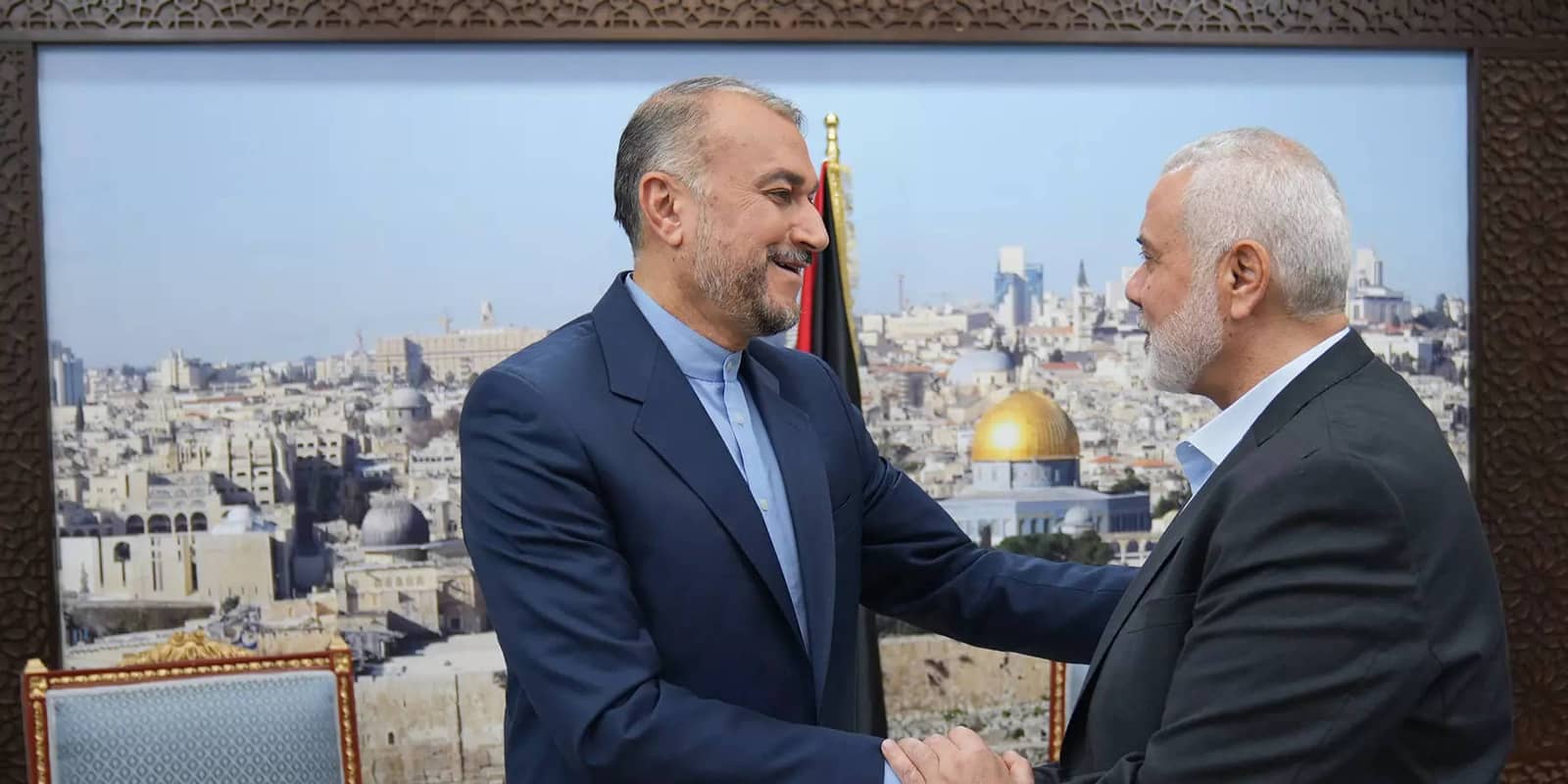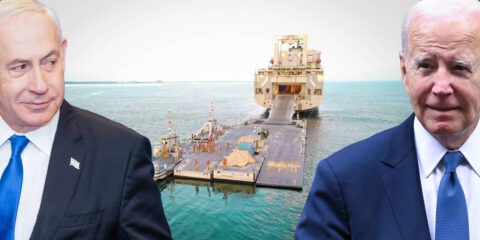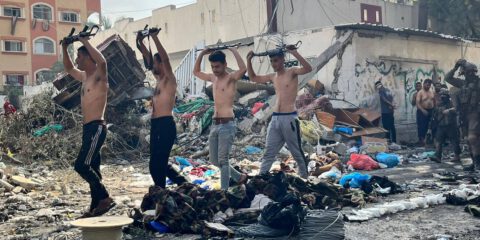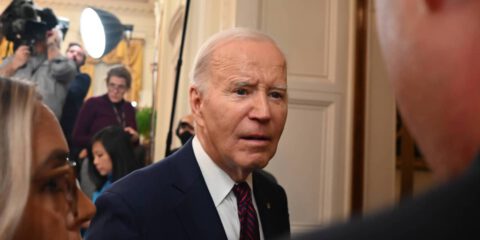High-ranking Iranian officials praised Hamas’ brutal massacre of Israeli civilians, thereby demonstrating their unwarranted support for crimes against humanity. Iran funds and supports the murder of Israeli and Jewish civilians and endorses antisemitic ideology. If the regime is not made to pay a price, Iran will have no reason to stop its subversive aggression.
Was Iran involved?
The debate on whether Iran knew about Hamas’ plans to carry out its brutal assault is simply ignorant of the modus operandi of Iran-funded terrorism. Like any other leadership, the Iranian leadership is unaware of the technical details of the operations of their intelligence services. It is doubtful that United States presidents, for example, have ever been briefed about the operative minutiae of CIA operations. Iran’s support for terrorism is managed in a way that precludes the involvement of the top leadership. Its non-involvement enables plausible deniability for Tehran.
Moreover, Iran has traditionally outsourced terrorist activities to its proxies, such as Hezbollah. The only Iranian service involved is the IRGC Quds Force, which works with Hezbollah and other Iranian proxies. The Quds Force was created precisely for that purpose, namely conducting terrorist activities abroad and obscuring the role of Iran’s leadership.
The principles of Iran’s strategy and command structure allow a lot of room for maneuvering for its proxies. In other words, the Quds Force – or Hezbollah – provides equipment and training, but never imposes a rigid, detailed plan, or the timing of operations. Such an approach not only allows the client independent tactical decision-making but also enhances information safety.
Iran’s involvement in the terrorist attack against Israel is sometimes referred to with an intonation of surprise as if it were something unexpected. Yet, this should not come as a surprise given that the Islamic Republic has been engaged in terrorism against Americans and Jews (Israelis or not) since its establishment in 1979. Suffice it to evoke the hostage crisis in Lebanon in the 1980s, horrendous terrorist attacks against Israel’s embassy in Buenos Aires in 1992, and the Jewish community in the same city in 1994. The Mossad thwarted a terrorist attack against Jewish and Israeli civilians in Athens in 2022.
Iran’s Quds Force directed and approved these attacks, but local Iranian proxies carried out the ground operations, including the provision of logistical support. With the bombing in Argentina, it was local Hezbollah networks that perpetrated the two murderous attacks. In neither case did the Iranian command give precise orders related to all the details of the attacks. Thus, one should talk not about Iran’s involvement, but about Iran’s role behind the scenes of the terrorist attacks.
Antisemitic ideology motivates Iran’s leadership
The antisemitic, irrational dimension of the Khomeinist ideology is often neglected by scholars and analysts. Ignoring that dimension hinders a better understanding of Iranian behavior. It is noteworthy that Iranian ideology has nothing irrational or mystical, given that the Shi’a political Islam at the helm in Tehran is essentially a political ideology with religious coloration. Islamist ideology imbued with antisemitism existed in Iran even before Khomeini. It manifested itself in the movement ‘Fadayen-e Eslam” under the leadership of Navvab Safavi. The latter established connections with the Egyptian Muslim Brotherhood and became Khomeini’s tutor. Countless Iranian articles, books, and slogans state that the disappearance of the Zionist regime is an ideal of the Islamic revolution.
High-ranking Iranian officials praised Hamas’ brutal massacre of Israeli civilians, thereby demonstrating their unwarranted support for crimes against humanity.
The chief of staff of the Iranian Army, Major General Mohammad Bagheri, stated that the “Al-Aqsa Storm” operation had turned Israel’s collapse into an inevitable reality.
The political advisor of the revolutionary leader and a member of the Council for the Determination of Interest (and the commander of the IRGC navy), Ali Shamkhani, posted a tweet supporting the terrorist attack against Israel, saying that “Operation Al-Aqsa Flood” was an example of legitimate defense against the criminal regime of the occupation. The Twitter post was also published in Hebrew, Russian, English, and Arabic
Iranian President Ebrahim Raisi held a telephone conversation with Hamas leader Ismail Haniyeh and Islamic Jihad leader Ziyad al-Nakhalah and discussed with them developments in the “Tufan al-Aqsa” situation. The content of many IRGC-related Persian language Telegram accounts is perfectly coordinated with Hamas-affiliated Arabic channels: Everything that appears on a Hamas channel in Arabic is immediately broadcast on Hezbollah and Iranian channels. Thus, even if Iran was unaware of the Hamas attack, it is unquestionably one of the key participants and belligerent parties.
Iran has been working to step up Hamas-Hezbollah coordination
Many signs of growing coordination between Iran, Hezbollah, and Hamas could be seen over the past few months. During his visit to Lebanon in September, Iranian Foreign Minister Hossein-Amir Abdollahian met not only with Hezbollah Secretary-General Hassan Nasrallah but also with Hamas leader Salah al-Arouri. Hezbollah is helping Hamas build a military infrastructure in south Lebanon. The logic of Iran and Hezbollah is that it is always better to engage Israel on two fronts.
Hezbollah wants a multi-front campaign against Israel so that Israel does not concentrate its efforts on the northern arena alone. According to the Al-Hadath News Channel (Lebanon), the Quds Force and Hezbollah coordinated the transfer of arms to Hamas in Lebanon. Hezbollah helped Hamas complete the takeover of the Ein al-Hilweh refugee camp in south Lebanon. This was the last refugee camp that remained under PLO control.
While none of these reports provide conclusive proof of Iran’s direct involvement in the Hamas attack on October 7, its efforts to enhance cooperation between the two terrorist organizations are evident. In any event, the execution of the attack indicates a high professional level and implies Iranian guidance through Hezbollah adopting the modus operandi of the Lebanese group’s elite Radwan force.
Iran’s goals in the war
Since October 7, Iran has shown no desire to prevent escalation. The opposite is true: IRGC-affiliated social media accounts have expressed total support for Hamas, Islamic Jihad, and Hezbollah. Iranian media have descended to the most rabid antisemitism. Worst of all, Iranian media not only praise Hamas’ “resistance,” they also blur its murderous dimensions and dehumanize Israeli victims. For example, the Tabnak website posted graphic footage of the murder of an Israeli soldier by a “resistance combatant,” praising the latter’s confirmed kill with a shot to the head of a hiding” Zionist.” Slain Israeli civilians are labeled merely as “Zionists.”
The Tehran regime ordered militias under its tutelage to deploy in Syria and to step up attacks on American bases there and in Iraq. The commander of the Kataib Sayyid al-Shuhada militia, Abu Ala al Walai was spotted on the Lebanese-Israeli border on 16 October. Sayyid al-Shuhada is a small Iraqi militia commanded directly by the IRGC Quds force. Meanwhile, on Tehran’s orders, the Houthis in Yemen launched missiles and drones against Israel, but these were intercepted by a U.S. Navy destroyer positioned in the Gulf.
Iran faces a crucial dilemma: on the one hand, it does not want to throw its strategic asset, Hezbollah, into a battle that it is unlikely to win. On the other hand, Tehran has the opportunity to further weaken Israel. After the deadly blow that Israeli society has already been dealt, it might not recover. Moreover, Iran is weighing the ramifications of Hamas’ potential destruction by Israel. If this happens with Hezbollah contenting itself with sporadic fire against northern Israel, the organization risks losing its credentials as the “leader of the resistance.” That, in turn, will cost Iran and Hezbollah their image as caretakers for the umma and will only exacerbate their perception as Shi’ite usurpers among the Sunni Muslims. Thus, the most plausible option for Iran and Hezbollah is to follow the fight in Gaza while intensifying Hezbollah’s attacks. However, those attacks should not deteriorate into a full-fledged war in order not to provoke an inevitable Israeli counterattack.
Iran can afford such brinkmanship because it is always the Arab militias who fight on its behalf, never Iran itself, as it is wary of dragging itself into a direct military confrontation with Israel or the US.
The regime must pay the price
The public Iranian embrace of the unprecedented murder of Israeli citizens and the ongoing funding of terrorist attacks against Jewish citizens makes any military or intelligence operation against the Iranian regime perfectly moral and legitimate.
Iran will have no reason to stop this subversive aggression if the regime is not made to pay a price. Iran funds and supports the murder of Israeli and Jewish civilians and endorses antisemitic ideology. Any lethal action against this regime is legitimate and justified, even when its goal is not the thwarting of a specific terrorist attack.
It is noteworthy that the objective of a preemptive strike on the Iranian regime would have nothing to do with its nuclear military program. The goal of such a strike would be to signal to the regime that, in the event of Hezbollah inflicting civilian losses on Israel, the Iranian regime will not be able to hide behind its proxy’s back. Its leaders and assets will be in danger.
Discussions regarding a potential strike against Iran usually face cognitive obstacles resulting from a lack of knowledge about that nation:
Iran is a large country, with porous borders with seven countries that run the length of almost 6,000 kilometers and a further 2,500 kilometers of coastline. In terms of conventional military power, it is very weak; it has no armored corps, air force, or rapid response units and this makes the country even more vulnerable. This military weakness warrants Iran’s wariness of any direct military confrontation with Israel or the US.
As of October 2023, Israel is already facing the prospect of a regional war, even without a strike on Iran. Yet we must keep in mind that this is a war fought by Iran through its regional proxies and not a direct military confrontation between Iran and Israel. Iran has no allies, and no country will fight alongside Iran against its rivals. The repercussions of any Israeli or American military action against Iran have been intentionally depicted in apocalyptic terms. Also, the fact of conflict with Iran has been described in a binary way, namely, arguing that the choice is between the appeasement of Iran and an out-and-out war for regime change. Needless to say, the facts on the ground have little to do with such a binary analysis.
An attack on Iran could lead to a full-scale Hezbollah attack on Israel. Undoubtedly, this risk does exist and cannot be discarded. However, regional and possibly global realities have drastically alternated in the aftermath of October 7. Hezbollah is already attacking Israel. No military or geopolitical option is risk-free. It is plausible to assume that Iranian leaders might become more cautious once they see their lives and assets are under threat.
The overwhelming majority of Iranians are wary of war and do not share the official regime ideology of hatred and antisemitism. Exposing and practically demonstrating the regime’s vulnerability might strengthen the urge to resist the regime’s oppression. Targeting the regime’s assets and officials will not lead the people of Iran to rally around the flag; the opposite is true.
The regional and global aspects of the victory over the Iranian axis
We need a paradigm shift to deal with radical Islam. The victory over the Iranian “axis of resistance” is indispensable not only for Israel but for the free world as well. What is strange is that revelations about the activities of the pro-Iranian lobby in the United States have not sparked any public uproar. These activities include the contacts of the administration’s former Iran envoy, Rob Malley, with Iranian officials, pro-Iranian academics, etc. Such indulgence risks being misinterpreted in Tehran and this exacerbates the risks of escalation. The US ought to demonstrate to Iran the falsehood of what Iran perceives as American weakness.
The peace process and eventual normalization between Israel and Arab states, with their culmination in the shape of the Abraham Accords, are based on the Arab understanding that Israel is here to stay. It is also understood that force cannot subdue it, whereas cooperation with Israel has mutual advantages.
The Hamas-ISIS type massacre of Israeli civilians on Israeli soil dealt a serious blow not only to Israel’s deterrence but to the view that Israel is the safest place in the world for Jews. Israel must restore and enhance its deterrence and restore a sense of security to its citizens. The Iranian regime must be prevented by all means necessary, from profiting in any way from the current crisis.
Political Islam remains the only serious alternative to moderate Arab regimes. Following the Hamas attack, the time has come to realize once and for all that any distinction between the various branches of Islamist movements is artificial and non-sensical. The difference between ISIS, the Muslim Brotherhood, Hamas, or Iranian Shi’ite Khomeinism and the latter’s Iranian and Lebanese branches resides in secondary nuances and not in their essence.
If Hamas is not destroyed physically and Iran is not punished, all other Islamists might perceive October 7 as a victory. The fact that an Islamist movement managed to strike Israel in a way that no Arab army has ever dreamed of, may “inspire” local Islamists across the Arab world to enhance their activities at home. Moreover, the “success” of the Shi’ite resistance doctrine would automatically enhance Hezbollah’s and Iran’s popularity in Sunni countries to the detriment of traditional Islam in those countries.
For all these reasons, the outcome of Israel’s battle for its existence is of utmost importance for peace and stability in the Middle East. Other global bullies, such as Russia and China, must be deterred as well. This is why Hamas must be physically eliminated and the Iranian regime must pay exorbitant prices for its misdoings.
The final lesson to the world and the region’s bullies and criminals must be that aggression and barbarity never pay off. A movement or a nation that adopts murderous antisemitism never stops with the Jews alone, and inevitably ends up inflicting catastrophe and ruin on its nation. The greater the number of Hamas operatives and Iranian Revolutionary Guards killed and the greater the ruin inflicted on them, the more stable the peace will be.
JISS Policy Papers are published through the generosity of the Greg Rosshandler Family.
Photo: IMAGO / ZUMA Wire








 - בניית אתרים
- בניית אתרים